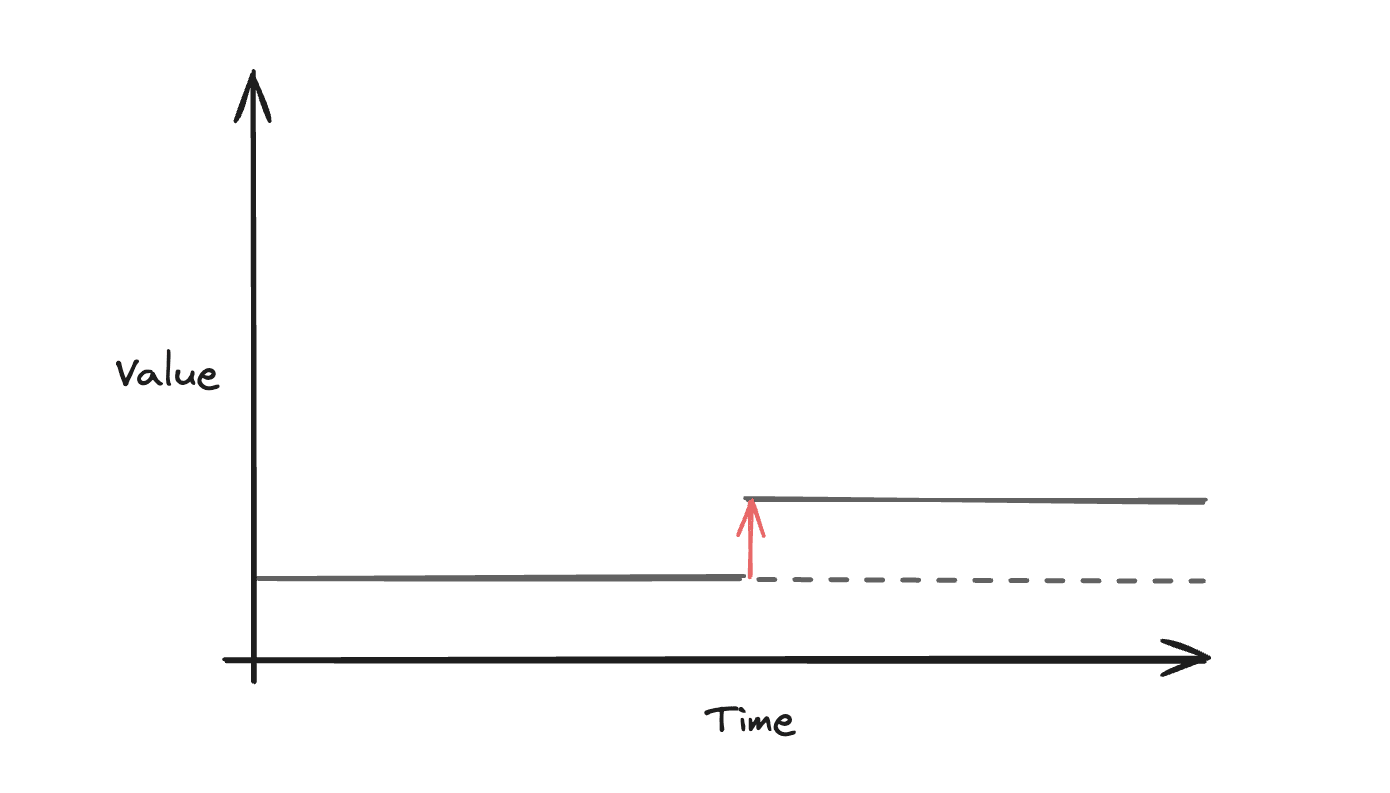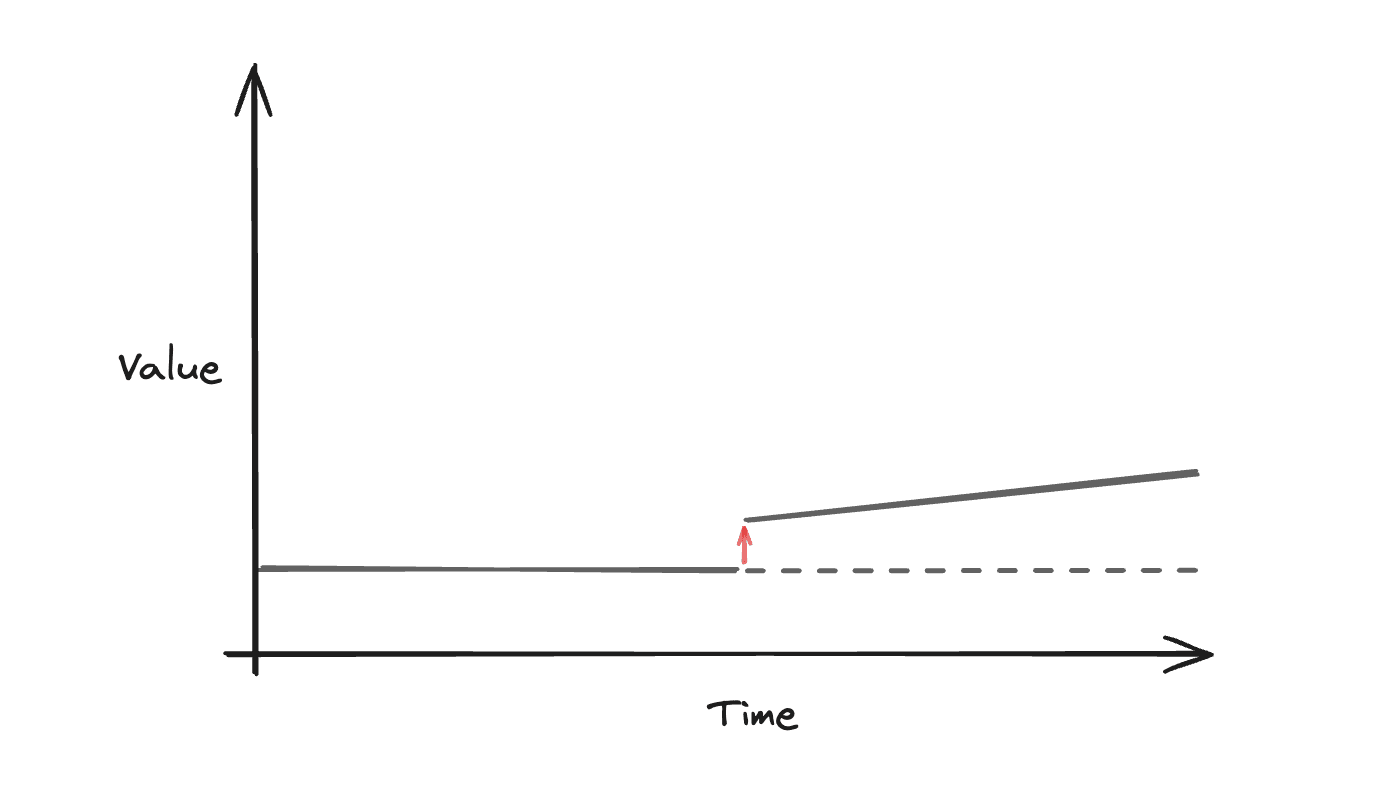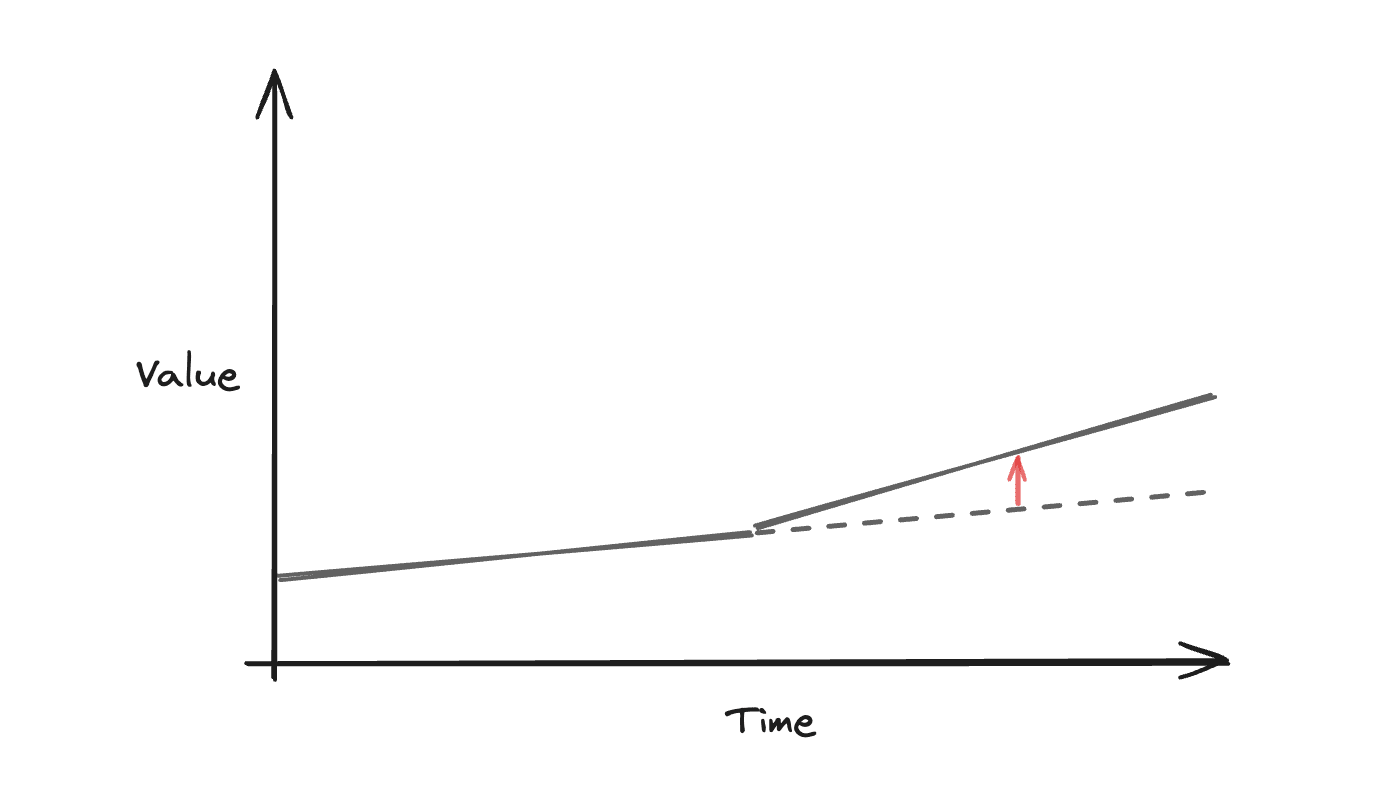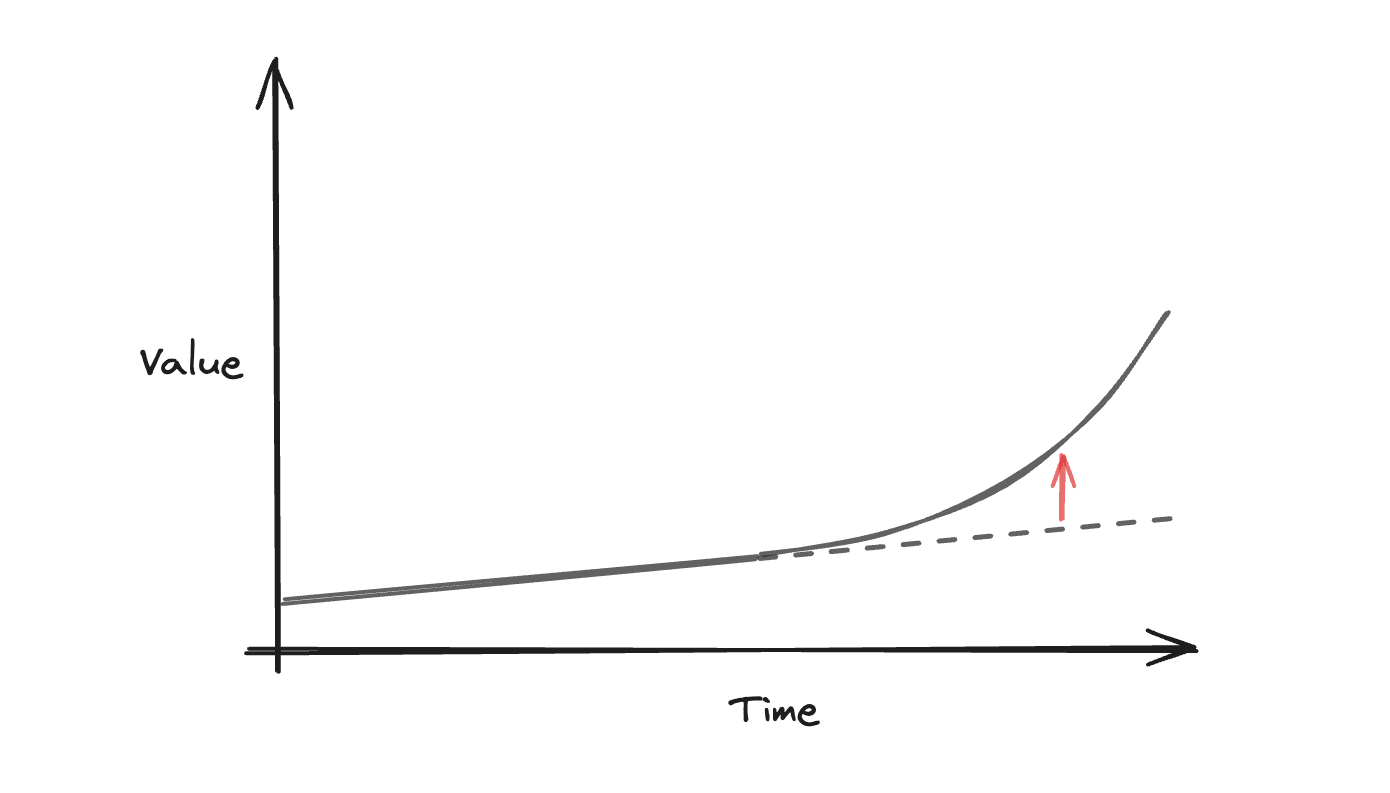In the past I've been confused by level frameworks. They often read to me as "incremental steps towards becoming a manager" or "just do bigger projects over time" or "your level is your years of experience," in a way that doesn't feel tied to fundamental value.
Things got a lot clearer for me once I started using a simple polynomial model of career growth. The model answers these questions:
- What does it mean to be a junior, mid-level, senior, and principal member of the team?
- How do you grow within each level?
- How do you level up?
- What risks do you need to watch out for?
- Why are senior people sometimes less effective at startups?
It's a crude model and reality is complex, but I've found it helpful as one tool in my toolbox, both for making my own work more impactful and helping our team do the same.
Framework
Your level is how your successful work adds value
To figure out your level in a role, look at the level of your successful contributions - how do they usually add value to the team? Here are the levels we’ll talk about:
- Junior work is additive. It adds constant value per contribution.
- Mid-level work keeps on giving even after it’s done, adding more value over time.
- Senior work multiplies the value produced by your team.
- Principal work increases our growth rate. It sets up feedback loops that lead to compounding growth.
Senior or principal work can be worse. It works in an environment that’s already productive at junior and mid levels, and companies that are just starting out aren't. If you multiply 0 value or 0 growth, you’re still at 0. As a company or function grows, the room for senior and principal work grows with it. Some of our functions still benefit most from junior and mid-level work.
What value means differs between roles
Ultimately, value is about how well we accomplish Elicit’s mission - scaling up good reasoning. Day to day, it’s usually more helpful to think about your function:
| Product | How well do we understand what’s needed to make Elicit capable? |
| Engineering | How capable is Elicit? |
| HR | How many Elicians are on our team, and how effective are they? |
| Sales | What’s our revenue? |
| Support | How much value are users getting out of Elicit as it is? |
Junior work is additive
The model
A junior contribution adds constant value to the team:
If v* is the new value function:
If your work were Cookie Clicker, you would be clicking to get a cookie. If your work were gardening, you would be watering a plant.
Successes
Much of our successful foundational work takes the shape of junior contributions:
| Product | Interviewing a user and embedding with user teams to learn what our users want Documenting a feature request and scoping out what's needed to implement it |
| Engineering | Implementing a simple feature Reviewing code (without teaching generalizable lessons) |
| HR | Reaching out to an interesting person on Twitter to hire them Interviewing an applicant and writing up a scorecard |
| Sales | Referring a sales prospect Making a sale by following an established playbook |
| Support | Responding to an individual user request |
Failures
The risk at this level is low. Failure usually means that work wastes your own time and that the opportunity cost wasn’t worth it. This has happened to us a lot, too:
| Product |
|
| Engineering |
|
| HR |
|
| Sales |
|
| Support |
|
Career growth
Growth within the junior level means adding more value per contribution (e.g. implementing bigger features) and making more frequent contributions.
You’ll soon see patterns in your work, or ways to automate your own work. Maybe you also notice inefficiencies in your team or the organization. If you can find ways to set up systems that add more value than you could on your own, and that keep on giving even when you’re not investing in them, you may be ready to level up.
An equally important dimension of career growth is being aware of when junior work is needed. When senior employees join startups, they sometimes don't see that they'd be more valuable to the team if they contributed high-quality additive work at a rapid pace rather than make more leveraged contributions, and no one else on the team can tell whether that's the right call.
Mid-level work keeps on giving
The model
Mid-level work adds a permanent linearly growing contribution to the team:
That is:
This is mostly independent of other work by your team - you’re creating a source of value that keeps on giving over time, even without further investment.
In Cookie Clicker, you’d now be buying auto-clicking cursors and grandmas. As a gardener, you’d be sowing seeds that grow to be trees over time.
Successes
A lot - but not all - of this is infra that we’ve set up to automate work that our team did manually before:
| Product |
|
| Engineering |
|
| HR |
|
| Sales |
|
| Support |
|
Failures
The risk at this level is significant.
The focus on setting up systems and doing indirect work can make you less effective than if you just made direct contributions. As a heuristic, if over 1-3 months you could have gotten more done with junior work than through more leveraged contributions, you or the team might not be ready for this level.
A few of the cases where we encountered this:
| Engineering | At Ought, the non-profit that incubated Elicit, we created ICE, a visual debugger for language model programs, in 2022. The project was ahead of its time but didn’t obviously result in a big impact of any kind. |
| HR | Providing and advertising a $5,000 hiring bonus for external referrals. We didn’t really get any referrals. Podcast ads for recruiting haven’t led to many applicants Recruiting agencies had a very low return of our time investment |
Career growth
Career growth at mid-level means that you make increasingly big and frequent improvements to slope, i.e. your work increasingly has long-run benefits. Over time, you might notice that besides making these contributions directly, you can also make the rest of your team more efficient in a way that outpaces what you can do on your own. Usually mid-level and senior work happens around the same time for a person, and is sometimes hard to distinguish.
Senior work multiplies the team’s effort
The model
A senior contribution is a permanent multiplier on your team’s effort:
That is:
The more productive your team already is, the more this helps. If the team invests time and effort , we now maybe get out of it instead of . If the team isn’t productive already, this won’t help.
As a senior Cookie Clicker, you’d be upgrading grandmas and using sugar lumps to level up buildings, multiplying your click rates. In gardening, you’d be sharing knowledge about synergistic plants with your team, like corn + beans + squash with the corn providing structure for the beans, the beans fixing nitrogen in the soil, and the squash suppressing weeds and retaining soil moisture.
Successes
As a team, we’re strong at making each other more productive, so there’s a lot in this category:
| Product |
|
| Engineering |
|
| HR | |
| Sales |
|
| Support |
|
| Misc |
|
Failures
Beyond potentially being less efficient than one-off work, systems can actively slow down progress. For example, suppose you require all PRs to have detailed descriptions; the cost to team efficiency could easily be higher than the gains. We haven’t encountered this a lot (that we know), but here are a few examples:
Even when senior work is helpful, it's easy to err on the side of complexity when a simpler solution would be more effective.
| Product |
|
| Engineering |
|
| HR |
|
| Misc |
|
Career growth
Career growth at a senior level means using systems thinking to find ways to generate compounding growth. This requires setting up self-amplifying feedback loops, a rarity.
Principal work increases the growth rate
The model
A principal contribution permanently increases our growth rate, i.e. leads to growth that compounds more quickly.
That is:
This is powerful if the value is already big, but the magic of compound returns can turn even small starting values into huge outcomes given time.
Setting up feedback loops can happen as a manager, but doesn’t have to. It does benefit from being able to effectively work across functions and teams though.
In Cookie Clicker, you've reached the principal level if you're stacking golden cookie combos, or telling your nephew to keep clicking the upgrade button for you. In gardening, you’d be setting up ecosystems of perennial plants that grow and multiply over time with little intervention.
Successes
Both success and failure are rare here, mostly because it’s hard to spot any opportunities for compounding growth.
| Product |
|
| Engineering |
|
| HR |
|
| Misc |
|
Failures
| Product | Early Elicit supported user-made tasks - worth trying, but almost all tasks that people actually used were made by us, so we didn’t see compounding growth here Elicit previously supported sharing of URLs, which was used some but not enough to get a growth loop off the ground Part of our long-term motivation for Elicit Notebooks is to let users define custom multi-step workflows that they can share with others; however, so far we’re mostly seeing usage with one or two steps |
| Sales | For enterprise sales, the compound growth loop is “more sales → more revenue → hire more sales people → more sales”. While our product is still changing rapidly, it’s hard to get this loop off the ground. |
Career growth
Career growth at this level means bigger increases in growth rate and more frequent increases. Almost no one makes successful principal contributions with any regularity, so the first aim should be to do this repeatedly at all.
Caveat: It’s a simple model
Work can be additive within a single team, but multiplicative from another team’s point of view. For example:
- Hiring a tech lead is additive from the HR team’s perspective, but multiplicative from the engineering team’s perspective.
- Implementing a feature is additive from the engineering team’s perspective but can permanently increase returns from the product team’s perspective.
I’ve mostly thought about work from within each team’s perspective. A better model would take into account cross-team effects, and ideally the information value of exploratory work as well, but all of this is heuristics anyway so I didn't try to be super rigorous.
Summary
A company is an engine that generates value. Elicit aims to scale up good reasoning, so for us value is measured by how much we help with good reasoning.
Elicit is made out of many smaller engines, each with its own value metrics. Product defines what’s needed to scale up good reasoning, engineering figures out how to implement it, sales and support make it available to users and capture some of the value for our future growth, and hiring builds out the team.
In this picture:
- Junior work adds constant value fuel to each engine, effectively providing a one-time jump ahead.
- Mid-level and senior work tune existing engines so they’re more efficient, increasing the speed with which they generate value.
- Principal work builds new engines or connects existing ones, increasing our growth rate.
To succeed at scale, view your work in the context of building more efficient and better engines. And if you're not at Elicit yet - join us!
Acknowledgments
Thanks to Jungwon Byun, Panda Smith, Adam Wiggins, and Venki Kumar for helpful feedback.




